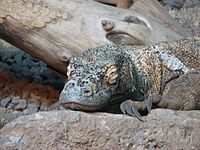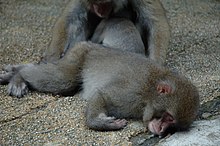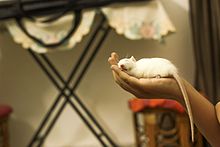Secondary metabolism produces a large number of specialized compounds (estimated 200,000) that do not aid in the growth and development of plants but are required for the plant to survive in its environment. Secondary metabolism is connected to primary metabolism by using building blocks and biosynthetic enzymes derived from primary metabolism. Primary metabolism governs all basic physiological processes that allow a plant to grow and set seeds, by translating the genetic code into proteins, carbohydrates, and amino acids. Specialized compounds from secondary metabolism are essential for communicating with other organisms in mutualistic (e.g. attraction of beneficial organisms such as pollinators) or antagonistic interactions (e.g. deterrent against herbivores and pathogens). They further assist in coping with abiotic stress such as increased UV-radiation. The broad functional spectrum of specialized metabolism is still not fully understood. In any case, a good balance between products of primary and secondary metabolism is best for a plant’s optimal growth and development as well as for its effective coping with often changing environmental conditions. Well known specialized compounds include alkaloids, polyphenols including flavonoids, and terpenoids. Humans use quite a lot of these compounds, or the plants from which they originate, for culinary, medicinal and nutraceutical purposes.
History
Research
into secondary plant metabolism primarily took off in the later half of
the 19th century, however, there was still much confusion over what the
exact function and usefulness of these compounds were. All that was
known was that secondary plant metabolites
were "by-products" of the primary metabolism and were not crucial to
the plant's survival. Early research only succeeded as far as
categorizing the secondary plant metabolites but did not give real
insight into the actual function of the secondary plant metabolites. The
study of plant metabolites is thought to have started in the early
1800s when Friedrich Willhelm Serturner isolated morphine from opium
poppy, and after that new discoveries were made rapidly. In the early
half of the 1900s, the main research around secondary plant metabolism
was dedicated to the formation of secondary metabolites in plants, and this research was compounded by the use of tracer techniques which made deducing metabolic pathways
much easier. However, there was still not much research being conducted
into the functions of secondary plant metabolites until around the
1980s. Before then, secondary plant metabolites were thought of as
simply waste products. In the 1970s, however, new research showed that
secondary plant metabolites play an indispensable role in the survival
of the plant in its environment. One of the most ground breaking ideas
of this time argued that plant secondary metabolites evolved in relation
to environmental conditions, and this indicated the high gene
plasticity of secondary metabolites, but this theory was ignored for
about half a century before gaining acceptance. Recently, the research
around secondary plant metabolites is focused around the gene level and
the genetic diversity of plant metabolites. Biologists are now trying to
trace back genes to their origin and re-construct evolutionary
pathways.
Primary vs. Secondary Plant Metabolism
Primary
metabolism in a plant comprises all metabolic pathways that are
essential to the plant's survival. Primary metabolites are compounds
that are directly involved in the growth and development of a plant
whereas secondary metabolites are compounds produced in other metabolic
pathways that, although important, are not essential to the functioning
of the plant. However, secondary plant metabolites are useful in the
long term, often for defense purposes,
and give plants characteristics such as color. Secondary plant
metabolites are also used in signalling and regulation of primary
metabolic pathways. Plant hormones, which are secondary metabolites, are
often used to regulate the metabolic activity within cells and oversee
the overall development of the plant. As mentioned above in the History
tab, secondary plant metabolites help the plant maintain an intricate
balance with the environment, often adapting to match the environmental
needs. Plant metabolites that color the plant are a good example of
this, as the coloring of a plant can attract pollinators and also defend
against attack by animals.
Types of Secondary Metabolites in plants
There
is no fixed, commonly agreed upon system for classifying secondary
metabolites. Based on their biosynthetic origins, plant secondary
metabolites can be divided into three major groups:
- Flavonoids and allied phenolic and polyphenolic compounds,
- Terpenoids and
- Nitrogen-containing alkaloids and sulphur-containing compounds.
Other researchers have classified secondary metabolites into following, more specific types
| Class | Type | Number of known metabolites | Examples |
|---|---|---|---|
| Alkaloids | Nitrogen-containing | 21000 | Cocaine, Psilocin, Caffeine, Nicotine, Morphine, Berberine, Vincristine, Reserpine, Galantamine, Atropine, Vincamine, Quinidine, Ephedrine, Quinine |
| Non-protein amino acids (NPAAs) | Nitrogen-containing | 700 | NPAAs are produced by specific plant families such as Leguminosae, Cucurbitaceae, Sapindaceae, Aceraceae and Hippocastanaceae. Examples: Azatyrosine, Canavanine |
| Amines | Nitrogen-containing | 100 |
|
| Cyanogenic glycosides | Nitrogen-containing | 60 | Amygdalin, Dhurrin, Linamarin, Lotaustralin, Prunasin |
| Glucosinolates | Nitrogen-containing | 100 |
|
| Alkamides | Nitrogen-containing | 150 |
|
| Lectins, peptides and polypeptides | Nitrogen-containing | 2000 | Concanavalin A |
| Terpenes | Without nitrogen | >15,000 | Azadirachtin, Artemisinin, Tetrahydrocannabinol |
| Steroids and saponins | Without nitrogen | NA | These are terpenoids with a particular ring structure. Cycloartenol |
| Flavonoids and Tannins | Without nitrogen | 5000 | Luteolin, tannic acid |
| Phenylpropanoids, lignins, coumarins and lignans | Without nitrogen | 2000 | Resveratrol |
| Polyacetylenes, fatty acids and waxes | Without nitrogen | 1500 |
|
| Polyketides | Without nitrogen | 750 |
|
| Carbohydrates and organic acids | Without nitrogen | 200 |
|
Some of the secondary metabolites are discussed below:
Atropine
Atropine is a type of secondary metabolite called a tropane alkaloid. Alkaloids contain nitrogens, frequently in a ring structure, and are derived from amino acids.
Tropane is an organic compound containing nitrogen and it is from
tropane that atropine is derived. Atropine is synthesized by a reaction
between tropine and tropate, catalyzed by atropinase.
Both of the substrates involved in this reaction are derived from
amino acids, tropine from pyridine (through several steps) and tropate
directly from phenylalanine. Within Atropa belladonna atropine synthesis has been found to take place primarily in the root of the plant.
The concentration of synthetic sites within the plant is indicative of
the nature of secondary metabolites. Typically, secondary metabolites
are not necessary for normal functioning of cells within the organism
meaning the synthetic sites are not required throughout the organism.
As atropine is not a primary metabolite, it does not interact specifically with any part of the organism, allowing it to travel throughout the plant.
Flavonoids
Flavonoids are one class of secondary plant metabolites that are also known as Vitamin P or citrin.
These metabolites are mostly used in plants to produce yellow and other
pigments which play a big role in coloring the plants. In addition,
Flavonoids are readily ingested by humans and they seem to display
important anti-inflammatory, anti-allergic and anti-cancer activities.
Flavonoids are also found to be powerful anti-oxidants and researchers
are looking into their ability to prevent cancer and cardiovascular
diseases. Flavonoids help prevent cancer by inducing certain mechanisms
that may help to kill cancer cells, and researches believe that when the
body processes extra flavonoid compounds, it triggers specific enzymes
that fight carcinogens. Good dietary sources of Flavonoids are all
citrus fruits, which contain the specific flavanoids hesperidins, quercitrin,and rutin,
berries, tea, dark chocolate and red wine and many of the health
benefits attributed to these foods come from the Flavonoids they
contain. Flavonoids are synthesized by the phenylpropanoid metabolic pathway where the amino acid phenylalanine is used to produce 4-coumaryol-CoA, and this is then combined with malonyl-CoA to produce chalcones which are backbones of Flavonoids Chalcones
are aromatic ketones with two phenyl rings that are important in many
biological compounds. The closure of chalcones causes the formation of
the flavonoid structure. Flavonoids are also closely related to flavones
which are actually a sub class of flavonoids, and are the yellow
pigments in plants. In addition to flavones, 11 other subclasses of
Flavonoids including, isoflavones, flavans, flavanones, flavanols,
flavanolols, anthocyanidins, catechins (including proanthocyanidins),
leukoanthocyanidins, dihydrochalcones, and aurones.
Cyanogenic glycoside
Many plants have adapted to iodine-deficient terrestrial environment
by removing iodine from their metabolism, in fact iodine is essential
only for animal cells.
An important antiparasitic action is caused by the block of the transport of iodide of animal cells inhibiting sodium-iodide symporter (NIS). Many plant pesticides are cyanogenic glycoside which liberate cyanide, which, blocking cytochrome c oxidase
and NIS, is poisonous only for a large part of parasites and herbivores
and not for the plant cells in which it seems useful in seed dormancy phase.
To get a better understanding of how secondary metabolites play a big
role in plant defense mechanisms we can focus on the recognizable
defense-related secondary metabolites, cyanogenic glycosides. The
compounds of these secondary metabolites (As seen in Figure 1) are found
in over 2000 plant species. Its structure allows the release of cyanide,
a poison produced by certain bacteria, fungi, and algae that is found
in numerous plants. Animals and humans possess the ability to detoxify
cyanide from their systems naturally. Therefore, cyanogenic glycosides
can be used for positive benefits in animal systems always. For example,
the larvae of the southern armyworm consumes plants that contain this
certain metabolite and have shown a better growth rate with this
metabolite in their diet, as opposed to other secondary
metabolite-containing plants. Although this example shows cyanogenic
glycosides being beneficial to the larvae many still argue that this
metabolite can do harm. To help in determining whether cyanogenic
glycosides are harmful or helpful researchers look closer at its
biosynthetic pathway (Figure 2). Past research suggests that cyanogenic
glucosides stored in the seed of the plant are metabolized during
germination to release nitrogen for seedling to grow. With this, it can
be inferred that cyanogenic glycosides play various roles in plant
metabolism. Though subject to change with future research, there is no
evidence showing that cyanogenic glycosides are responsible for
infections in plants.
Phytic acid
Phytic acid is the main method of phosphorus storage in plant seeds, but is not readily absorbed by many animals (only absorbed by ruminant animals). Not only is phytic acid a phosphorus storage unit, but it also is a source of energy and cations, a natural antioxidant for plants, and can be a source of myoinositol which is one of the preliminary pieces for cell walls.
Phytic acid is also known to bond with many different minerals,
and by doing so prevents those minerals from being absorbed; making
phytic acid an anti-nutrient.
There is a lot of concern with phytic acids in nuts and seeds because
of its anti-nutrient characteristics. In preparing foods with high
phytic acid concentrations, it is recommended they be soaked in after
being ground to increase the surface area. Soaking allows the seed to undergo germination which increases the availability of vitamins and nutrient, while reducing phytic acid and protease inhibitors,
ultimately increasing the nutritional value. Cooking can also reduce
the amount of phytic acid in food but soaking is much more effective.
Phytic acid is an antioxidant
found in plant cells that most likely serves the purpose of
preservation. This preservation is removed when soaked, reducing the
phytic acid and allowing the germination and growth of the seed. When
added to foods it can help prevent discoloration by inhibiting lipid
peroxidation.
There is also some belief that the chelating of phytic acid may have potential use in the treatment of cancer.
Gossypol
Gossypol
has a yellow pigment and is found in cotton plants. It occurs mainly
in the root and/or seeds of different species of cotton plants.
Gossypol can have various chemical structures. It can exist in three
forms: gossypol, gossypol acetic acid, and gossypol formic acid. All of
these forms have very similar biological properties. Gossypol is a type
of aldehyde, meaning that it has a formyl group. The formation of
gossypol occurs through an isoprenoid pathway. Isoprenoid pathways are
common among secondary metabolites.
Gossypol's main function in the cotton plant is to act as an enzyme
inhibitor. An example of gossypol's enzyme inhibition is its ability to
inhibit nicotinamide adenine dinucleotide-linked enzymes of Trypanosoma
cruzi. Trypanosoma cruzi is a parasite which causes Chaga's disease.
For some time it was believed that gossypol was merely a waste
product produced during the processing of cottonseed products.
Extensive studies have shown that gossypol has other functions. Many of
the more popular studies on gossypol discuss how it can act as a male contraceptive. Gossypol has also been linked to causing hypokalemic paralysis. Hypokalemic
paralysis is a disease characterized by muscle weakness or paralysis
with a matching fall in potassium levels in the blood. Hypokalemic
paralysis associated with gossypol in-take usually occurs in March, when
vegetables are in short supply, and in September, when people are
sweating a lot. This side effect of gossypol in-take is very rare
however. Gossypol induced hypokalemic paralysis is easily treatable
with potassium repletion.
Phytoestrogens
Plants synthesize certain compounds called secondary metabolites which
are not naturally produced by humans but can play vital roles in
protection or destruction of human health. One such group of metabolites
is phytoestrogens, found in nuts, oilseeds, soy, and other foods. Phytoestrogens are chemicals which act like the hormone estrogen. Estrogen is important for women's bone and heart health, but high amounts of it has been linked to breast cancer. In the plant, the phytoestrogens are involved in the defense system against fungi.
Phytoestrogens can do two different things in a human body. At low
doses it mimics estrogen, but at high doses it actually blocks the
body's natural estrogen.
The estrogen receptors in the body which are stimulated by estrogen
will acknowledge the phytoestrogen, thus the body may reduce its own
production of the hormone. This has a negative result, because there are
various abilities of the phytoestrogen which estrogen does not do. Its
effects the communication pathways between cells and has effects on
other parts of the body where estrogen normally does not play a role.
It has also been found to induce tumor growth of the estrogen receptor
cells in the breast.
But, one role of estrogens which phytoestrogens mimic is its protective
behavior for the heart. So, an intake of phytoestrogens has also been
seen to reduce the risk of cardiovascular disease. Resveratrol,
a phytoestrogen found in grapes is responsible for this. For example,
the French suffer relatively little heart disease despite the average
French diet being relatively high in fat. One proposed reason for this
is the resveratrol found in red wine, which has been linked to decreased
risk of cardiovascular disease.
Carotenoids
Carotenoids are organic pigments found in the chloroplasts and chromoplasts
of plants. They are also found in some organisms such as algae, fungi,
some bacteria, and certain species of aphids. There are over 600 known
carotenoids. They are split into two classes, xanthophylls and carotenes. Xanthophylls are carotenoids with molecules containing oxygen, such as lutein and zeaxanthin. Carotenes are carotenoids with molecules that are unoxygenated, such as α-carotene, β-carotene and lycopene.
In plants, carotenoids can occur in roots, stems, leaves, flowers, and
fruits. Carotenoids have two important functions in plants. First, they
can contribute to photosynthesis. They do this by transferring some of
the light energy they absorb to chlorophylls,
which then uses this energy for photosynthesis. Second, they can
protect plants which are over-exposed to sunlight. They do this by
harmlessly dissipating excess light energy which they absorb as heat. In
the absence of carotenoids, this excess light energy could destroy
proteins, membranes, and other molecules. Some plant physiologists
believe that carotenoids may have an additional function as regulators
of certain developmental responses in plants. Tetraterpenes
are synthesized from DOXP precursors in plants and some bacteria.
Carotenoids involved in photosynthesis are formed in chloroplasts;
Others are formed in plastids. Carotenoids formed in fungi are
presumably formed from mevalonic acid precursors. Carotenoids are formed
by a head-to-head condensation of geranylgeranyl pyrophosphate or
diphosphate (GGPP) and there is no NADPH requirement.

















